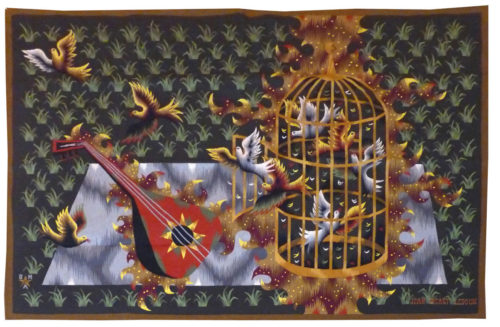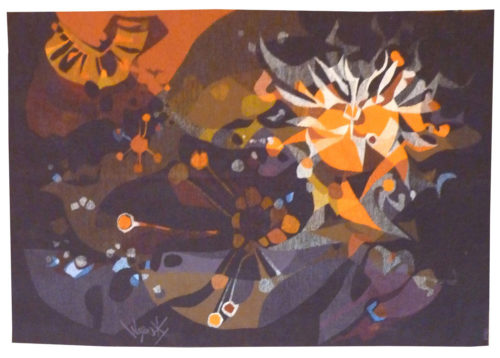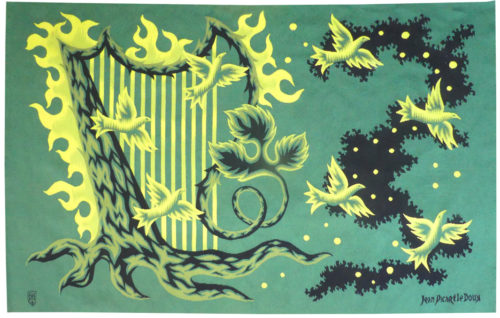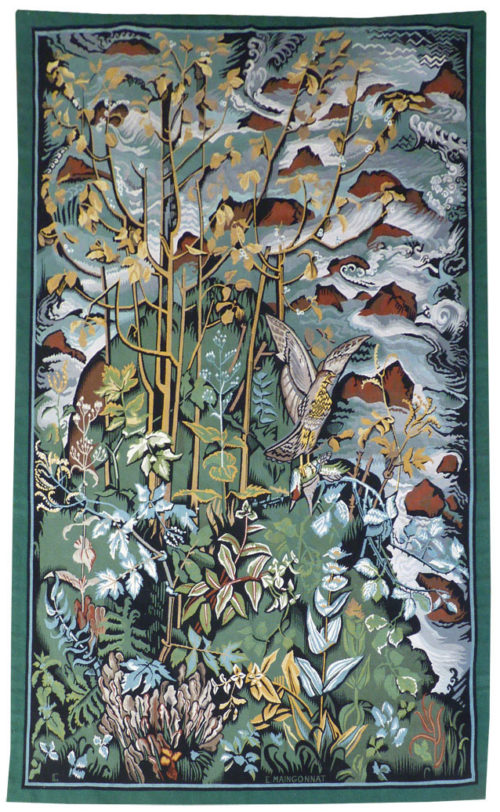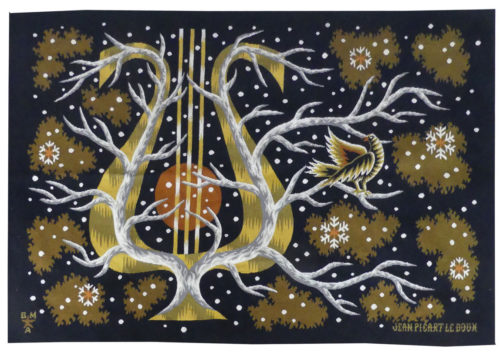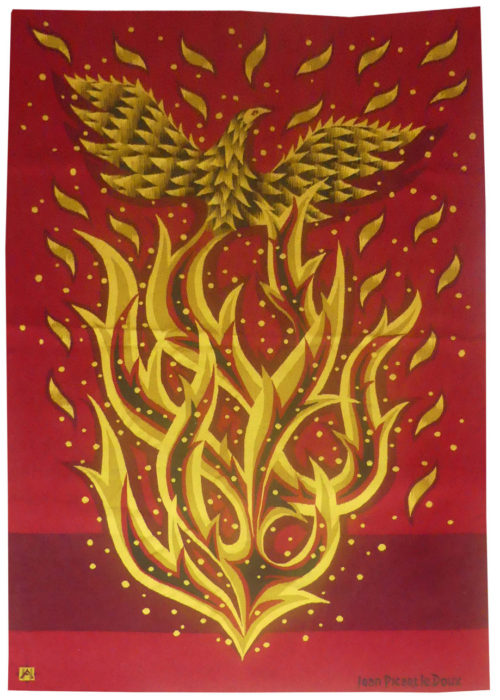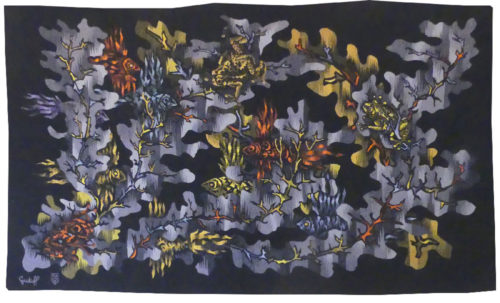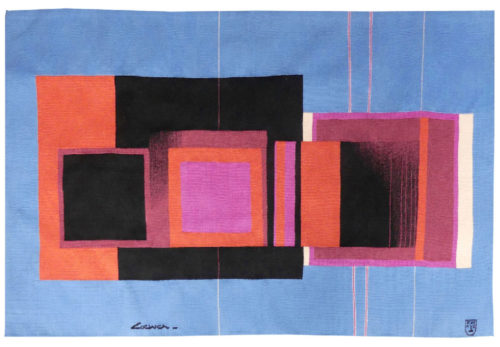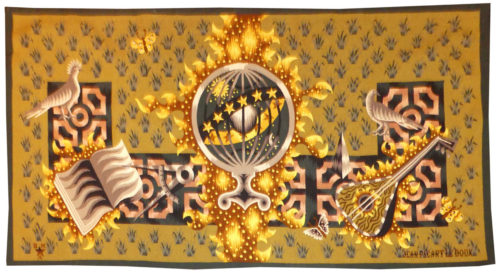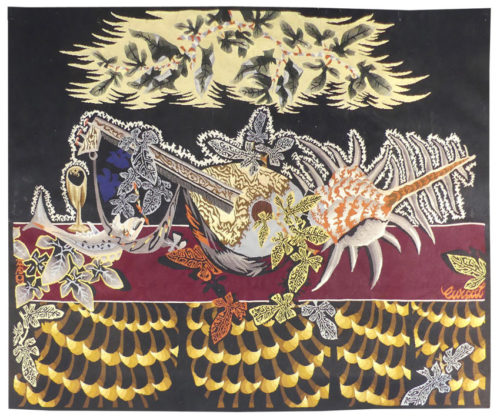-
Vega
Aubusson tapestry woven in the Legoueix workshop. Certificate of origin signed by the artist n° 2 of 4. 1967. A member of the A.P.C.T. (Association des Peintres-Cartonniers de Tapisserie), Wogensky is one of the many artists who would follow in Lurçat’s footsteps immediately after the war. At first influenced by his predecessor, Wogensky’s subsequent work (159 cartoons according to the 1989 exhibition catalogue) would evolve during the 1960’s towards a, not completely self-avowed, lyrical abstraction, from cosmic-astronomical themes expressed in decomposed, moving, birdlike shapes to cartoons both more refined and less dense. Although always claiming to be a painter, the artist’s conception of tapestry is extremely well thought out : “the realisation of a mural cartoon.... requires the consideration of a space which is no longer ours alone, by the nature of its dimensions, its scale, it also imposes a grand gesture which transforms and accentuates our presence.” « Vega » is a work inspired by Wogensky’s « cosmic » vein (it’s title alone bears witness to the fact) which lasted through the 1960’s and of which “Cosmos” (1968 Strasbourg University) and “Galaxy” (1970, Sénat Palais du Luxembourg) would be the high points. Shading (omnipresent) and blocks of colour co-exist in a subtle harmony, evoking a curious, unknown world with elements of the infinitely small as seen through a microscope and the infinitely large. Bibliography : Exhibition catalogue Robert Wogensky, Aubusson, Musée départemental de la tapisserie, 1989 Exhibition catalogue Robert Wogensky, Angers, Musée Jean Lurçat et de la Tapisserie Contemporaine, 1989 -
Concert des oiseaux (concert of birds)
Tapestry woven in the Picaud workshop. Complete with certificate of origin signed by the artist, n°4/6. Circa 1975. Jean Picart le Doux is one of the foremost figures in the renaissance of the art of tapestry. His earliest contributions to the field date back to 1943 when he designed cartoons for the passenger ship “la Marseillaise”. A close associate of Lurçat, whose theories he would adopt (limited palette, numbered cartoons...), he was a founding member of the A.P.C.T. (Association des Peintres-cartonniers de Tapisserie), and soon after, a teacher at the Ecole Nationale Supérieure des Arts Décoratifs. The state gave him several commissions most of them at the Aubusson workshop, and some at the Gobelins : the most spectacular of these being for the University of Caen, the Theatre in Le Mans, the passenger ship France or the Prefecture of the Creuse département ... In as much as Picart le Doux’s aesthetic is close to that of Lurçat, so also is his inspiration and his subject matter, although in a register which is more decorative than symbolic, where he brings together heavenly bodies (the sun, the moon, the stars...), the elements, nature (wheat, vines, fish, birds...), man, literary quotation ... Music as a theme is frequently associated with birds in Picart le Doux’s work ; this particular cartoon is an extension of the « harpe des forêts” tapestry dating from 1953. Bibliography : Maurice Bruzeau, Jean Picart le Doux, Murs de soleil, Editions Cercle d’art, 1972 Exhibition Catalogue, Jean Picart le Doux, tapisseries, Musée de Saint-Denis, 1976 Exhibition Catalogue Jean Picart le Doux, Musée de la Poste, 1980 -
le tiercelet (the sparrow hawk)
Aubusson tapestry woven by the Legoueix workshop. Complete with certificate of origin signed by the artist's beneficiary, n° E.A.1 1942. Elie Maingonnat governed the Ecole Nationale des Arts Décoratifs d’Aubusson from 1930 until 1958 where he took over from Marium Martin (who already recommended the use of a limited number of colours and the use of hachures, a similar technique to hatching) of whom he was a pupil. As well as assuming the responsibilities of his position, Maingonnat devoted himself to designing cartoons : motifs of dense vegetation animated by the presence of a few animals, both of which were inspired by the flora and fauna of the Limousin area of France revitalising the traditional theme of greenery used in the XVIIth and XVIIIth centuries. This cartoon is typical of Maingonnat’s work : local flora and fauna (here a diminutive sparrow hawk among gentians on the bank of a mountain stream) are illustrated in a limited grey-green spectrum which is reflected and emphasised by the browns of the stones in the river. Bibliographie : Exhibition Catalogue Elie Maingonnat, Aubusson, Musée départemental de la tapisserie, 1986-1987, Ill. -
Etoiles de neige (Snow Flakes)
Aubusson tapestry woven in the Berthaut workshop. N°7/8. 1962. Jean Picart le Doux is one of the foremost figures in the renaissance of the art of tapestry. His earliest contributions to the field date back to 1943 when he designed cartoons for the passenger ship “la Marseillaise”. A close associate of Lurçat, whose theories he would adopt (limited palette, numbered cartoons...), he was a founding member of the A.P.C.T. (Association des Peintres-cartonniers de Tapisserie), and soon after, a teacher at the Ecole Nationale Supérieure des Arts Décoratifs. The state gave him several commissions most of them at the Aubusson workshop, and some at the Gobelins : the most spectacular of these being for the University of Caen, the Theatre in Le Mans, the passenger ship France or the Prefecture of the Creuse département ... In as much as Picart le Doux’s aesthetic is close to that of Lurçat, so also is his inspiration and his subject matter, although in a register which is more decorative than symbolic, where he brings together heavenly bodies (the sun, the moon, the stars...), the elements, nature (wheat, vines, fish, birds...), man, literary quotation ... The theme of winter is chracterised in Picart le Doux’s work by the use of templates, colours (muted tones, browns, black, white), and motifs (bare branches, kaleidoscopic flake shapes) ; the snow flakes referred to here will also be used in “Solstice d’hiver” and “Hommage à Vivaldi”. Bibliography : Maurice Bruzeau, Jean Picart le Doux, Murs de soleil, Editions Cercle d’art, 1972, ill. n°122 Exhibition Catalogue, Jean Picart le Doux, tapisseries, Musée de Saint-Denis, 1976 Exhibition Catalogue Jean Picart le Doux, Musée de la Poste, 1980 -
Le phénix (the phoenix)
Aubusson tapestry woven in the Hamot workshop. Complete with label signed by the artist, n°EA. 1965. Jean Picart le Doux is one of the foremost figures in the renaissance of the art of tapestry. His earliest contributions to the field date back to 1943 when he designed cartoons for the passenger ship “la Marseillaise”. A close associate of Lurçat, whose theories he would adopt (limited palette, numbered cartoons...), he was a founding member of the A.P.C.T. (Association des Peintres-cartonniers de Tapisserie), and soon after, a teacher at the Ecole Nationale Supérieure des Arts Décoratifs. The state gave him several commissions most of them at the Aubusson workshop, and some at the Gobelins : the most spectacular of these being for the University of Caen, the Theatre in Le Mans, the passenger ship France or the Prefecture of the Creuse département ... In as much as Picart le Doux’s aesthetic is close to that of Lurçat, so also is his inspiration and his subject matter, although in a register which is more decorative than symbolic, where he brings together heavenly bodies (the sun, the moon, the stars...), the elements, nature (wheat, vines, fish, birds...), man, literary quotation ... « Le Phénix » (The Phoenix) (An identical lithograph exists also), a subject inspired by legend (a rare event in the work of Picard le Doux) reproduces a chromatic harmony of yellow motifs against a red background typical of this particular artist. Bibliography : Maurice Bruzeau, Jean Picart le Doux, Murs de soleil, Editions Cercle d’art, 1972, ill. n°162 Exhibition Catalogue, Jean Picart le Doux, tapisseries, Musée de Saint-Denis, 1976 Exhibition Catalogue Jean Picart le Doux, Musée de la Poste, 1980 -
Poissons et grenouilles (fish and frogs)
Aubusson tapestry woven by the Picaud workshop. Complete with signed label, n°1/4. Circa 1970. Elie Grekoff, whose aesthetic is similar to that of Lurçat, designed over 300 cartons : a black background evokes an underwater world where fish and leaves are pictured with the amusing and un-Lurçat-like presence of frogs. -
Argos
Aubusson tapestry woven by the Picaud workshop. Complete with signed certificate of origin, n° 1/4. 1971. Loewer designed his first cartoon in 1953 ; his early works are first figurative before turning to abstraction (like Matégot) which is exclusively geometric in Loewer’s case. He designed over 180 cartoons, most of which were woven by his friend, Raymond Picaud. Around 1971-1972, Loewer’s style became more refined, with fewer geometric squares and a brighter, more contrasted use of colour. As is often the case with Loewer, this is a one-off piece. Bibliography : Claude Loewer, l’évasion calculée : travaux de 1939 à 1993, catalogue raisonné des tapisseries de 1953 à 1974, Sylvio Acatos, Charlotte Hug, Walter Tschopp and Marc-Olivier Wahler, Artcatos, 1994, n°128 -
Sphère et colombes (Sphere and doves)
Aubusson tapestry woven in the Berthaut workshop. Complete with signed label. Circa 1954. Jean Picart le Doux is one of the foremost figures in the renaissance of the art of tapestry. His earliest contributions to the field date back to 1943 when he designed cartoons for the passenger ship “la Marseillaise”. A close associate of Lurçat, whose theories he would adopt (limited palette, numbered cartoons...), he was a founding member of the A.P.C.T. (Association des Peintres-cartonniers de Tapisserie), and soon after, a teacher at the Ecole Nationale Supérieure des Arts Décoratifs. The state gave him several commissions most of them at the Aubusson workshop, and some at the Gobelins : the most spectacular of these being for the University of Caen, the Theatre in Le Mans, the passenger ship France or the Prefecture of the Creuse département ... In as much as Picart le Doux’s aesthetic is close to that of Lurçat, so also is his inspiration and his subject matter, although in a register which is more decorative than symbolic, where he brings together heavenly bodies (the sun, the moon, the stars...), the elements, nature (wheat, vines, fish, birds...), man, literary quotation ... Typical of the associations that characterise his work, Picart le Doux here confronts Nature (organised in a formal French garden style) peopled by doves with 3 allegories : literature (a book) the arts (a mandoline), science (a sphere) : the incarnation of a classical mind. Bibliography : Maurice Bruzeau, Jean Picart le Doux, Murs de soleil, Editions Cercle d’art, 1972 Exhibition Catalogue, Jean Picart le Doux, tapisseries, Musée de Saint-Denis, 1976 Exhibition Catalogue Jean Picart le Doux, Musée de la Poste, 1980 -
Musique et coquillage (music and shell)
Aubusson tapestry woven by the Tabard workshop. Complete with label. Circa 1950. Lurçat’s artistic production was immense : it is however his role as the renovator of the art of tapestry design which ensures his lasting renown. As early as 1917, he started producing works on canvas, then in the 20’s and 30’s, he worked with Marie Cuttoli. His first collaboration with the Gobelins workshop dates back to 1937, at the same time he discovered the tapestry of the Apocalypse which was essential in his decision to devote himself to tapestry design. He first tackled the technical aspects with François Tabard, then on his installation at Aubusson during the war, he established his technique : broad point, a simplified palette, outlined cartoons with colours indicated by pre-ordained numbers. A huge production then follows (over 1000 cartoons) amplified by his desire to include his painter friends, the creation of the A.P.C.T. (Association des Peintres-Cartonniers de Tapisserie) and the collaboration with the art gallery La Demeure and Denise Majorel, and then by his role as a tireless advocate for the medium around the world. His tapestries reveal a pictorial world which is specifically decorative, with a very personal symbolic iconography : cosmogony (the sun, the planets, the zodiac, the four elements…) stylised vegetation, fauna (rams, cocks, butterflies, chimera …) standing out against a background without perspective (voluntarily different from painting) and, in his more ambitious work, designed as an invitation to share in a poetic (he sometimes weaves quotations into his tapestries) and philosophical (the grand themes are broached from the wartime period onwards) vision whose climax is the “Chant du Monde” (Song of the World) (Jean Lurçat Museum , ancien hôpital Saint Jean, Angers) which remained unfinished at his death. This piece (of which a copy is exhibited at the Cité de la Tapisserie in Aubusson) is a typical example of the laden table, recurrent in Lurçat’s work. The juxtaposition of a musical instrument and shellfish is a direct reference to the work of Picart le Doux. Bibliography : Tapisseries de Jean Lurçat 1939-1957, Pierre Vorms Editeur, 1957 Exhibition Catalogue Lurçat, 10 ans après, Musée d'Art moderne de la ville de Paris, 1976 Exhibition catalogue Les domaines de Jean Lurçat, Angers, Musée Jean Lurçat et de la tapisserie contemporaine, 1986 Symposium Jean Lurçat et la renaissance de la tapisserie in Aubusson, Aubusson, Musée départemental de la tapisserie 1992 Exhibition Catalogue Dialogues avec Lurçat, Musées de Basse-Normandie, 1992 Exhibition catalogue Jean Lurçat, Donation Simone Lurçat, Académie des Beaux-Arts, 2004 Jean Lurçat, le chant du monde Angers 2007 R. Guinot, la tapisserie d’Aubusson et de Felletin, Lucien Souny, 2009, ill. p.96 Gérard Denizeau, Jean Lurçat, Liénart, 2013 Exhibition Catalogue Jean Lurçat au seul bruit du soleil, Paris, galerie des Gobelins, 2016


